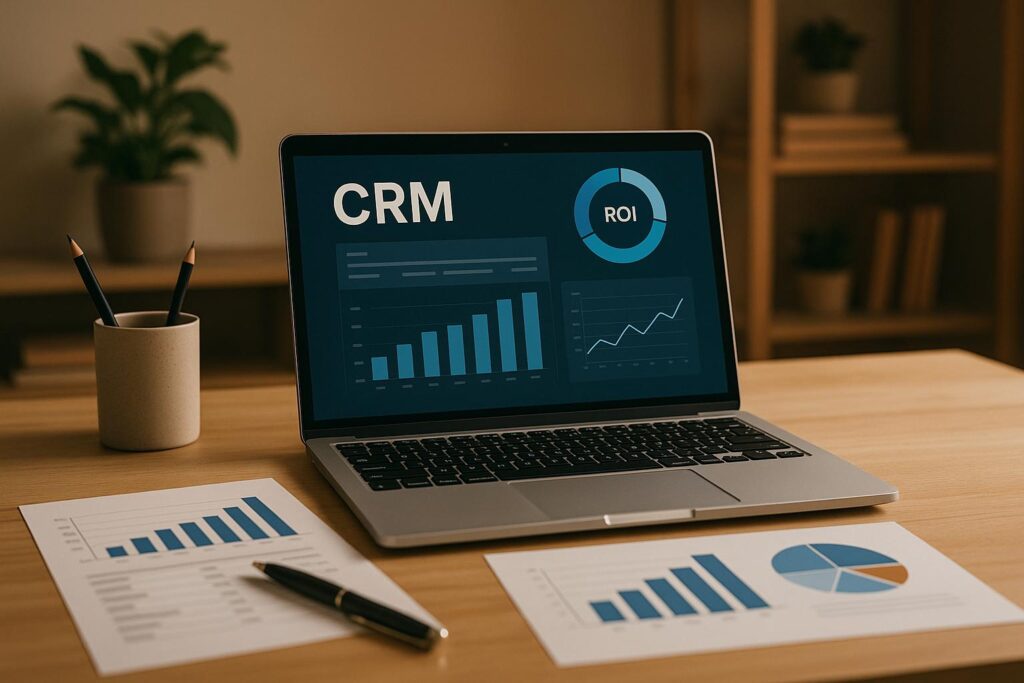CRM automation can deliver measurable returns by increasing revenue, reducing costs, and saving time. Businesses using automated CRM systems often see improved lead conversion rates, faster sales cycles, and reduced operational overhead. For example, automation can boost lead conversions by 15-30%, cut sales cycle times by 20-40%, and save each sales rep 10 hours per week by eliminating repetitive tasks.
Key benefits of CRM automation include:
- Revenue Growth: Larger deal sizes, upselling opportunities, and improved conversion rates.
- Cost Savings: Reduced manual labor, lower customer acquisition costs, and decreased churn rates.
- Scalability: Handle more leads without increasing staff.
To calculate ROI, use this formula:
ROI = (Total Value Gained – Total Cost) / Total Cost × 100
For instance, investing $50,000 in CRM automation that generates $150,000 in value results in a 200% ROI.
A Real-World Example of CRM Automation ROI
How to Calculate CRM Automation ROI
Figuring out the return on investment (ROI) for CRM automation might seem daunting at first, but it doesn’t have to be. By breaking it down into simple steps, you can measure both the financial benefits and cost savings CRM automation brings to your business. The goal is to focus on the numbers that genuinely reflect your outcomes.
The ROI Formula
Here’s the basic formula for calculating ROI:
ROI = (Total Value Gained – Total Cost) / Total Cost × 100
This formula gives you a percentage, showing how much return you’re earning for every dollar spent. Let’s look at an example: if you invest $50,000 in CRM automation and see $150,000 in added value, your ROI would be:
($150,000 – $50,000) / $50,000 × 100 = 200% ROI
In this case, you’re earning $2.00 for every $1.00 you invest – a strong return for most businesses. While the formula itself is straightforward, the real challenge lies in accurately measuring both the value gained and the total costs.
Measuring Value Components
When calculating ROI, the "Total Value Gained" includes revenue growth and cost savings. Breaking these down helps paint a clearer picture of how automation impacts your business.
Revenue Growth
Revenue growth often comes from several sources:
- Higher lead conversion rates: CRM automation can boost conversions by 15-30% within the first year. Features like lead scoring and automatic routing of hot leads to top-performing sales reps play a significant role here.
- Larger deal sizes: Businesses often see deal sizes grow by 10-20% due to better timing and opportunity management.
- Faster sales cycles: Automated follow-ups, meeting scheduling, and deal progression can reduce the time it takes to close deals by 20-40%.
Cost Savings
CRM automation also trims operational costs through efficiency gains:
- Reduced manual labor: Automating tasks like data entry can save each sales rep 10 hours per week. At $75 per hour, this equals $750 in weekly savings per rep. For a 25-person team, that’s $975,000 annually.
- Lower customer acquisition costs: Automated lead nurturing and scoring let you focus on high-potential prospects, cutting customer acquisition costs by 15-25%.
- Lower churn rates: Automated workflows can flag at-risk accounts and trigger retention campaigns, reducing churn by even 5%, which can have a major financial impact for subscription-based businesses.
Calculating Costs and Payback Period
To fully understand ROI, you also need to account for all costs associated with CRM automation:
- Software subscription fees: Most CRM platforms charge $25-$150 per user per month. For a 25-person sales team using a $75-per-user plan, annual software costs would be $22,500.
- Implementation costs: These include setup, data migration, and configuration. Mid-sized businesses typically spend $10,000-$50,000, depending on complexity.
- Training and onboarding: Training takes time and resources. For 25 users, with 20-40 hours of training at $50/hour, costs range from $25,000 to $50,000.
- Ongoing maintenance: System updates, workflow tweaks, and monitoring typically add 10-15% of your annual software costs.
Once you’ve calculated both the value gained and total costs, you can determine your payback period – the time it takes to recover your initial investment. For example, if your total first-year costs are $100,000 and CRM automation generates $15,000 in monthly value, your payback period would be:
$100,000 / $15,000 = 6.7 months
Payback periods between 6-18 months are common, with anything under 6 months indicating exceptional results. If it takes over 24 months, it may signal issues with implementation or unrealistic expectations.
CRM Automation ROI Benchmarks
Looking at how other businesses have benefited from CRM automation can help you set practical goals and shape your investment strategy. Across industries in the U.S., CRM automation is known for driving revenue growth and improving operational efficiency. These benchmarks offer a starting point for understanding the average ROI businesses are seeing.
Average ROI Numbers
Research shows that CRM automation can deliver impressive returns, though the exact results depend on factors like how well it’s implemented, the size of the company, and the specifics of the industry. Many B2B SaaS companies, for instance, have reported strong outcomes, often seeing positive returns within a short period after rolling out their CRM automation systems.
Revenue Growth and Cost Savings
One of the standout benefits of CRM automation is its ability to streamline lead management, which results in higher conversion rates and larger deal sizes. At the same time, it cuts operational costs by making customer acquisition more efficient and reducing the time spent on routine administrative tasks. This combination of increased revenue and reduced expenses highlights why CRM automation often delivers strong ROI.
Efficiency and Retention Improvements
CRM automation also helps sales teams work smarter. By automating follow-ups and account monitoring, sales reps can reclaim valuable hours to focus on closing deals and building stronger customer relationships. Studies have shown that automation can speed up the sales cycle by 20-30% while also boosting customer retention rates. These efficiency gains and improved retention further demonstrate the value of CRM automation.
These benchmarks serve as a guide for evaluating CRM automation investments, showing how a well-planned approach can lead to both financial gains and operational improvements tailored to the needs of today’s businesses in the U.S.
sbb-itb-647c22e
What Drives CRM Automation ROI
Understanding the key factors that drive CRM automation ROI can help businesses focus their efforts on areas that deliver the greatest impact. Three major contributors stand out: better pipeline management, higher-quality deals and customer lifetime value, and significant time savings through automation.
Pipeline and Conversion Optimization
CRM automation reshapes how businesses handle their sales pipelines by ensuring follow-ups are timely and high-potential leads get the attention they deserve. Features like automated lead scoring allow sales teams to rank prospects based on their engagement and fit, while trigger-based workflows ensure no follow-up falls through the cracks. This steady, timely communication minimizes missed opportunities and keeps qualified leads moving efficiently through the sales process. The result? A more streamlined pipeline that supports stronger deal quality and customer value.
Bigger Deals and Higher Customer Lifetime Value
Optimized pipelines naturally lead to better deals, but CRM automation takes it further. Automated tools not only increase the number of deals but also improve their quality. By tracking customer behavior and usage patterns, these systems can pinpoint upsell and cross-sell opportunities. For example, automation can alert teams when a customer is ready for an upgrade, opening the door to larger, more profitable deals. Additionally, features like improved onboarding, proactive retention strategies, and ongoing customer health monitoring help extend customer lifetime value.
Time Savings and AI-Powered Personalization
One of the most immediate perks of CRM automation is the time it saves for sales teams. By handling repetitive tasks like data entry, scheduling, and follow-ups, automation frees up time for more meaningful activities like researching prospects, building relationships, and closing deals. On top of that, AI-driven personalization takes customer engagement to the next level. By tailoring messages to individual behaviors and preferences, businesses can communicate more effectively and build stronger connections.
Together, these factors create a ripple effect on ROI. Better pipeline management improves deal flow, larger deals boost revenue, and time savings let teams seize more opportunities – all without adding extra staff.
Tools and Best Practices for Maximum ROI
The right combination of tools and strategies can significantly boost the return on investment (ROI) from CRM automation.
CRM Automation Tools
Thanks to no-code and low-code platforms, creating sophisticated workflows has become much more accessible. For example, Zapier simplifies trigger-based actions, making tasks like lead routing and follow-up sequences a breeze. Meanwhile, Make.com handles more advanced needs, offering multi-step workflows with conditional logic – perfect for tasks like advanced lead scoring or automating customer journeys. If you need even greater flexibility, n8n provides an open-source platform that supports customizations and handles complex data requirements, making it a great option for B2B SaaS companies with unique integration needs.
The key difference between these tools lies in their complexity and customization capabilities. While basic tasks like lead capture can be handled by almost any platform, more specialized workflows may demand tools that go beyond standard no-code features.
When off-the-shelf tools can’t keep up, it’s time to consider custom-built solutions.
Custom Solutions for Complex Needs
Custom-coded solutions are often the answer for businesses with specialized workflows, intricate data processing requirements, or unique system integrations.
For instance, SixtySixTen creates tailored automation systems that combine the ease of no-code platforms with the power of custom development. This approach is ideal for post-PMF (Product-Market Fit) B2B SaaS companies that have outgrown basic automation tools and need scalable, robust systems to support their growth.
Investing in custom solutions makes sense when the cost of manual processes outweighs the expense of automation. Automating repetitive tasks not only saves time and money but also improves response times and ensures better lead prioritization. The key is to align custom solutions with specific goals, such as reducing costs or driving revenue growth.
Once the right tools are in place, following clear implementation practices ensures long-term success.
Implementation Best Practices
Start by mapping out your current processes in detail. Document workflows, identify bottlenecks, and set clear metrics to measure success. Proper planning upfront makes it easier to align your team and ensure smooth adoption. Training and clear documentation are essential for getting everyone on board.
Begin with tasks that offer high impact but are relatively simple to automate. For instance, start with lead routing or basic follow-up sequences. Once those are running smoothly, you can expand into more complex areas like predictive lead scoring or personalized nurture campaigns.
Maintaining clean, standardized data is critical. Use validation rules and schedule regular data cleanups to keep workflows running efficiently.
Finally, track key metrics like conversion rates, response times, and user adoption. Regularly review and adjust workflows to ensure continuous improvement. When integrating tools, plan data flows carefully to avoid synchronization issues and eliminate data silos.
Conclusion: Getting the Most from CRM Automation
When done thoughtfully, CRM automation can transform how businesses operate, saving time and improving customer interactions in measurable ways.
Key Takeaways
To get the best results from CRM automation, focus on three main principles: tracking meaningful metrics, selecting the right tools, and rolling out changes methodically.
Start by defining baseline metrics – like conversion rates, deal velocity, customer acquisition costs, and team productivity – to measure success and justify your investment. These numbers will serve as a benchmark to track progress.
Choosing the right tools is equally important. For simpler workflows, platforms like Zapier can handle the job efficiently. However, if you’re managing more complex B2B SaaS operations, you might need advanced tools like n8n or custom-built systems. The trick is to match the tool’s complexity to your actual needs. Overcomplicating simple processes wastes resources, while underestimating complex ones can hinder growth.
When it comes to implementation, start small. Focus on tasks that are both high-impact and easy to automate, such as lead routing or follow-up sequences. Once these initial efforts are successful, you can branch out into more advanced areas, like predictive scoring or personalized nurture campaigns. This step-by-step approach minimizes risks and builds confidence within your team.
Lastly, remember that data quality is the foundation of automation. Clean, standardized data ensures that workflows run smoothly and deliver reliable results. Regularly maintaining and validating your data will help avoid problems that could disrupt your automation efforts.
By applying these principles, you’ll be better equipped to evaluate and refine your CRM processes, setting the stage for scalable automation.
Next Steps for U.S. Businesses
With this understanding, U.S. businesses can take concrete steps to improve their CRM automation strategies.
Start by reviewing your current workflows to identify manual tasks and bottlenecks that could benefit from automation. Repetitive activities like data entry or follow-up emails are prime candidates for streamlining.
Next, calculate your potential ROI. Use industry benchmarks and realistic estimates to assess the value of automating specific tasks. Factor in current labor costs, time spent on manual processes, and missed opportunities caused by delays. This analysis will help you prioritize the projects that will deliver the highest returns.
For companies with more advanced needs, consider consulting experts in scaling B2B SaaS operations. For example, SixtySixTen specializes in designing tailored automation systems that combine no-code platforms with custom development, ideal for post-PMF companies looking to scale their go-to-market strategies.
Investing in CRM automation can lead to increased revenue, lower costs, and more efficient teams. By acting now and choosing the right solutions, businesses can maximize their ROI and stay ahead in an increasingly competitive market.
FAQs
How can businesses measure the ROI of CRM automation effectively?
Businesses can evaluate the ROI of CRM automation by weighing the financial benefits – like higher revenue, lower operational costs, and saved time – against the total investment in the tools and processes. The result is typically expressed as a percentage.
To calculate this, start by pinpointing measurable benefits such as increased revenue, shorter sales cycles, or better customer retention rates. Next, subtract the costs associated with implementing and maintaining the CRM automation system. These costs can include software expenses, employee training, and ongoing support. Finally, divide the net financial gain by the total investment to determine the ROI.
By considering both measurable financial gains (like revenue boosts or cost savings) and operational efficiencies, businesses can clearly see how CRM automation impacts their overall profitability.
What challenges do businesses face with CRM automation, and how can they address them?
Businesses often encounter hurdles like resistance to change, poor data quality, integration challenges, and low user adoption when rolling out CRM automation. These challenges can derail progress and limit the potential benefits of automation.
To overcome these roadblocks, start by investing in thorough staff training and clearly outlining the advantages of automation to gain employee support. Performing a detailed data audit and cleanup before migration is crucial for ensuring consistent and reliable data. Partnering with CRM experts can also simplify the integration process, making it easier to align new systems with existing ones.
Choosing user-friendly tools and actively involving employees in the implementation process can greatly improve adoption rates, setting the stage for long-term success with CRM automation.
How does CRM automation help improve customer retention, and what are the best strategies to achieve this?
CRM automation takes customer retention to the next level by enabling personalized communication, timely follow-ups, and automated loyalty programs. With these tools, businesses can build stronger connections, minimize churn, and create a more satisfying experience for their customers. By handling routine tasks automatically, teams can dedicate more energy to fostering meaningful relationships.
To make the most of CRM automation, try these strategies:
- Leverage behavioral triggers to send offers or messages that align with customer actions.
- Set up automated discounts or rewards tailored to individual customer activity.
- Keep engagement consistent and relevant with customized email campaigns or notifications.
These tactics not only save time but also ensure every interaction feels intentional and meaningful.



